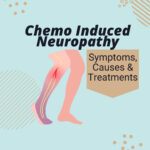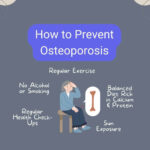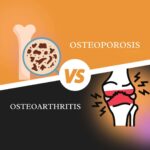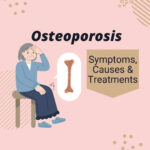Osteoporosis and arthritis are common bone and joint conditions among older adults that can significantly affect a person’s quality of life. Osteoporosis is characterized by low bone mass and an increased risk of fractures. On the other hand, osteoarthritis is a degenerative joint disease that involves inflammation and damage to the cartilage between joints. It commonly affects weight-bearing joints such as the knees, hips, and spine.
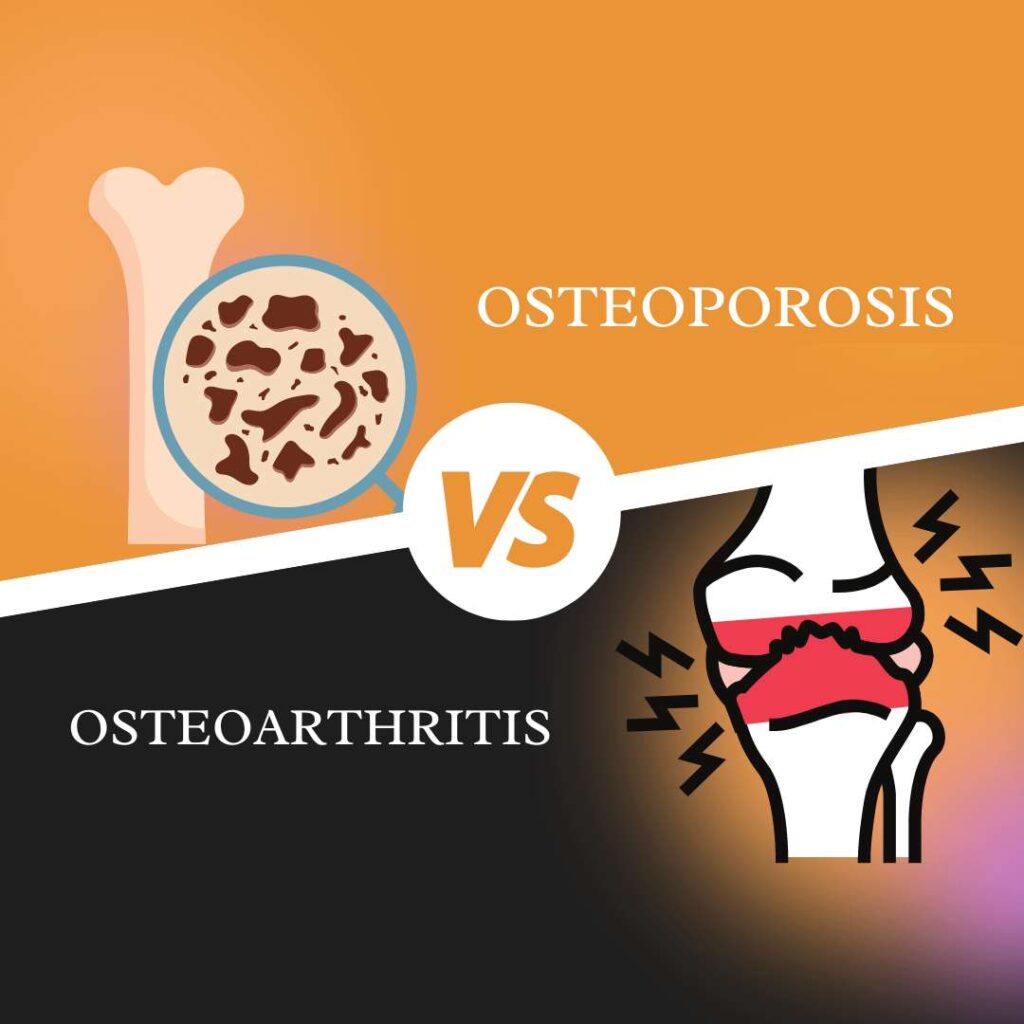
Differentiating Osteoporosis and Arthritis
Osteoporosis primarily affects the bones, whereas arthritis primarily affects the joints.
Arthritis and osteoporosiss may both cause pain, but they affect different parts of the body. Osteoporosis mainly impacts the bones, making them weak and susceptible to fractures. On the other hand, arthritis primarily affects the joints, causing inflammation and stiffness.
While both conditions can cause pain, they have different underlying causes and require different treatment approaches.
The causes of osteoporosis and arthritis are distinct. Osteoporosis often occurs due to a decrease in bone density as a person ages or due to hormonal changes. Arthritis, on the other hand, is typically caused by inflammation in the joints. The treatment approaches for these conditions also differ. Osteoporosis is usually managed through lifestyle changes such as regular exercise and a calcium-rich diet, along with medications if necessary. Arthritis treatment may involve medications to reduce inflammation, physical therapy exercises to improve joint mobility, or even surgery in severe cases.
It is possible for an individual to have both osteoporosis and arthritis simultaneously.
Although osteoporosis primarily affects bones and arthritis primarily affects joints, it is possible for someone to have both conditions at the same time. This means that an individual could experience bone weakness from osteoporosis alongside joint pain from arthritis.
Symptoms of Osteoporosis & Arthritis
Common Symptoms
Osteoporosis and arthritis are two different conditions that can affect the bones and joints. While they have distinct causes and treatments, they share some common symptoms.
- Pain: Both osteoporosis and arthritis can cause pain in the affected areas. Osteoporosis may lead to bone fractures, resulting in sudden or chronic pain. Arthritis often causes joint pain, which can range from mild to severe.
- Stiffness: People with osteoporosis or arthritis may experience stiffness in their bones or joints. This stiffness can make it difficult to move or perform daily activities.
- Swelling: Inflammation is a common symptom of both conditions. Osteoporosis-related fractures can cause swelling around the affected area, while arthritis often leads to joint inflammation and swelling.
- Limited Range of Motion: Both can restrict movement. Osteoporotic fractures may limit mobility, while arthritis can cause joint deformities that hinder normal range of motion.
Differentiating Symptoms
Although there are similarities, there are also specific symptoms that distinguish osteoporosis from arthritis.
- Osteoporosis Symptoms: Besides the common symptoms of pain, swelling, stiffness, and limited range of motion individuals with osteoporosis may experience height loss over time due to vertebral compression fractures. They might also notice a gradual change in posture as their spine curves forward (called kyphosis).
- Arthritis Symptoms: In addition to joint pain and inflammation, people with arthritis may experience redness and warmth around the affected joints. Some types of arthritis, such as rheumatoid arthritis, can also cause fatigue, fever, weight loss, and general malaise.
| Arthritis | Osteoporosis |
|---|---|
| Joint pain & inflammation | Bone pain |
| Joint stiffness & swelling | Fractures |
| Reduced range of motion | Loss of height |
| Redness & warmth | Stooped posture |
Causes of Osteoporosis & Arthritis
Common Causes
Osteoporosis and osteoarthritis have a few causes & risk factors in common.
Age: Both osteoporosis and osteoarthritis are more prevalent with advancing age.
Genetics: Family history can play a role in both conditions, suggesting a genetic predisposition.
Gender: Both conditions can affect both genders, but they are more common in women.
Lifestyle Factors: Sedentary lifestyle, lack of physical activity, and poor dietary habits can contribute to the risk of both conditions.
Differentiating Causes
Despite these common causes, there are specific causes and risk factors to each condition.
| Causes of Arthritis | Causes of Osteoporosis |
|---|---|
| Joint injury or trauma | Aging |
| Repetitive use of certain joints | Hormonal changes |
| Muscle Weakness | Medications |
| Excessive alcohol intake | |
| Smoking |
Diagnosing Osteoporosis and Arthritis
Osteoporosis Diagnosis
Osteoporosis, a condition characterized by weak and brittle bones, is diagnosed through a bone density test called dual-energy X-ray absorptiometry (DXA). This painless procedure measures the mineral content in your bones and compares it to the average for your age and gender. The results are then used to determine your bone density and assess your risk of fractures.
Arthritis Diagnosis
Diagnosing arthritis involves a combination of methods. Doctors will gather your medical history and conduct a physical examination, assessing joint swelling, tenderness, and range of motion. Imaging tests such as X-rays or MRI scans may be ordered to visualize joint damage or inflammation. In some cases, blood tests can help identify specific markers associated with certain types of arthritis.
Treatment Strategies for Osteoporosis and Arthritis
Common Treatment Options
- Lifestyle modifications such as regular exercise and maintaining a healthy diet.
- Red light therapy has proven to be effective for both conditions. By restoring cellular energy, cells can regenerate better to facilitate healing & repair from within.
Osteoporosis Treatment
Treatment for osteoporosis involves a combination of medications, supplements, and lifestyle modifications. Medications are used to increase bone density and reduce the risk of fractures. Calcium and vitamin D supplements are often recommended to support bone health.
Arthritis Treatment
The treatment of arthritis focuses on managing pain and inflammation. Medications such as nonsteroidal anti-inflammatory drugs (NSAIDs) or corticosteroids may be prescribed to alleviate symptoms. Physical therapy can help improve joint function and reduce pain. Assistive devices like braces or splints may be used to support affected joints. In severe cases, surgery may be necessary to repair or replace damaged joints.
Conclusion
In conclusion, osteoporosis and arthritis are two distinct conditions that affect the bones and joints, respectively. While they share some similarities in terms of symptoms and risk factors, it is important to understand their key differences in order to receive an accurate diagnosis and appropriate treatment. Osteoporosis is characterized by a loss of bone density, making bones weak and prone to fractures, while arthritis involves inflammation of the joints, leading to pain, stiffness, and reduced mobility.
Frequently Asked Questions
What is the difference between osteoporosis and arthritis?
Osteoporosis is a condition characterized by weak and brittle bones, while arthritis refers to inflammation of the joints. Osteoporosis primarily affects bone density, whereas arthritis affects joint function. They are distinct conditions with different causes, symptoms, and treatment options.
What are the common symptoms of osteoporosis and arthritis?
Common symptoms of both conditions are pain, stiffness, and limited range of motion.
- How To Improve Gut Microbiome – 26 May 2024
- Chemo neuropathy treatment: What to do? – 19 May 2024
- How to Prevent Osteoporosis: Effective Strategies & Simple Steps – 28 December 2023


